Physics Chapter 5 Sound
Sound is something we hear all the time around us, be it honking of cars on a busy road or chirping of birds in a serene landscape. It plays a major role in our lives where we receive and transmit sound for various purposes in our day-to-day life. Sound is a form of energy which propagates from one place to another through a medium. It is produced by bodies which vibrate. Consider a tuning fork ‘F’ which is excited by hitting on a rubber hammer.
When such a tuning fork is kept near our ears, we hear the sound but are unable to detect the vibrations of the tuning fork. When we speak, sound is produced by the vibration of vocal chords present in a cavity called larynx, in our throat. Sound is transmitted in the form of mechanical waves.
Thus, sound needs a medium to travel, since mechanical waves can propagate only through material medium.
In this chapter, we will learn more about sound and its propagation, its uses and its various forms in detail.
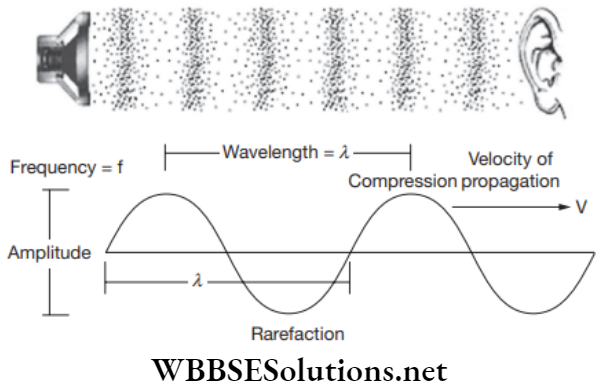
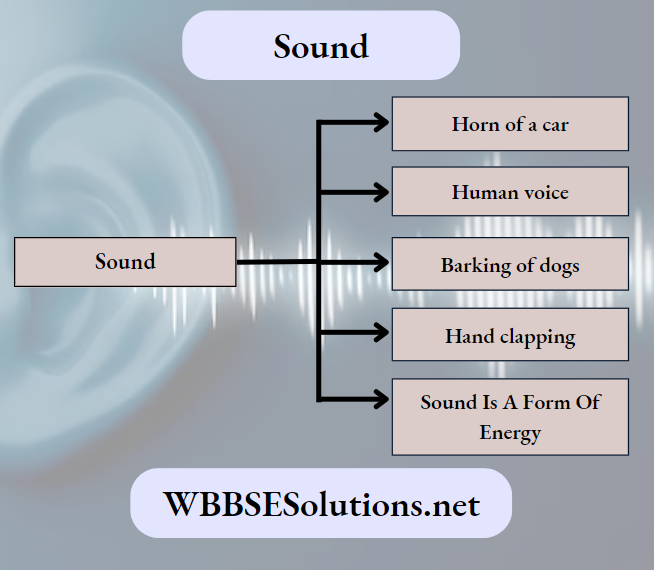
Chapter 5 Sound
Sound is a form of energy like heat energy, light energy, potential energy and kinetic energy. It causes a sensation of hearing in our ears. Sound cannot be created nor destroyed but can be changed from one form to another. For example, when we clap, a sound is produced.
Here, muscular energy is converted into sound energy. This is in accordance with the law of conservation of energy.
Read and Learn More: NEET Foundation Notes
Sound of various varieties is heard around us. We cannot see the sound but it travels in the form of waves and reaches our ears. These waves are formed due to vibrations of particles of the medium. Waves carry energy with them in the form of mechanical energy and produce a sensation of hearing in our ear.
Similarly, in an electric bell, when connected to electricity starts producing sound. Here, again electrical energy is converted into sound energy. Examples of sound discussed below.
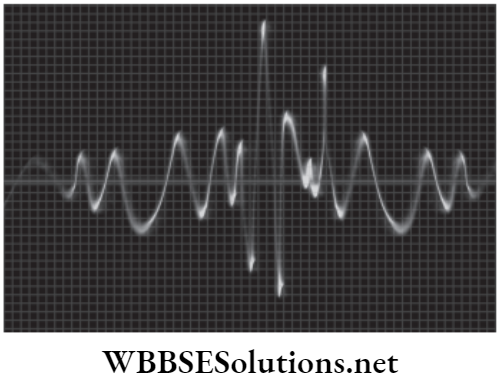
- Horn of a car
- Alarm clock
- Music
- Human voice
- Barking of dogs
- Hand clapping
Sound can be described in two different ways.
- Subjective or psychological sound, which refers to hearing sensation which ceases when the sound sensing organ is withdrawn from the scene.
- Objective or physical meaning refers to the energy reaching the ear from outside. The energy continues to propagate even if no ear is present to detect it.
Chapter 5 Sound Production of Sound
Sound is produced when an object vibrates. Now, what is vibration? Vibration is the rapid to and fro motion of an object. The motion of materials or objects causes vibration. To understand it better let us illustrate some examples.
Example 1: Take a guitar and pluck its string at the centre . Now pluck it at the centre. It will start vibrating and you can hear a sound. After few minutes, string will stop vibrating and sound will also stop as well.
Example 2: Take a U shaped fork. Hang a ball with a thread. Now strike the ball and bring the vibrating tuning fork near the ball. You will hear the sound of the vibrating tuning fork. As soon as the arm of the fork stops vibrating, the ball will also stop oscillating and there will be no sound.

These examples show that sound is produced when an object vibrates and it stops when the object stops vibrating.
As we said abovem sound is a form of energy. Let us elaborate it further. Mechanical energy is required to start vibrations in an object producing sound. The vibrations of object are transmitted in a medium in waveforms from one point to the next and so on.
These waves on reaching our ears produced vibrations in the eardrum which are perceived as sound by us. Thus, sound is a form of energy.
Chapter 5 Sound Master Your Test Question And Answers
Question 1. Define sound.
Answer:
Sound:
Sound is a form of energy which propagates from one place to another through a medium.
Question 2. How is sound produced?
Answer:
Sound is produced when an object vibrates. Vibration is the rapid to and fro motion of an object.
Question 3. Sound is a form of energy. Explain.
Answer:
Sound is a form of energy:
Mechanical energy is required to start vibrations in an object producing sound. The vibrations of object are transmitted in a medium in waveforms from one point to the next and so on. These waves on reaching our ears produce vibrations in the eardrum which are perceived as sound by us. Thus, sound is a form of energy.
Chapter 5 Sound Track Your Learning Question And Answers
Question 1. _______________ is required to start vibrations in an object producing sound.
Answer. Mechanical energy
Question 2. Sound is a form of _________________.
Answer. Energy
Question 3. The vibrating part of a guitar is
- Hand
- Fulcrum
- String
- Chords
Answer. 3. String
Question 4. Sound cannot be produced in a body if it’s not vibrating. (True/False)
Answer. True
Chapter 5 Sound Propagation of Sound
The vibrating object produces sound thattravels through a medium to reach the listener. The medium through which sound travels can either be solid, liquid or a gas. When an object vibrates, it creates a periodic disturbance in the nearby medium.
The particles around the medium also start vibrating. As a result of it, the particles in contact with the vibrating object is first displaced from its equilibrium position. It then exerts a force on the adjacent particle and the adjacent particle is displaced from its position of rest.
After displacing the adjacent particle the first particle comes back to its original position. This process gets repeated in the medium till the sound reaches the listener.
Therefore, the disturbance moves forward in the form of compression. The particles of the medium do not move with the compression.
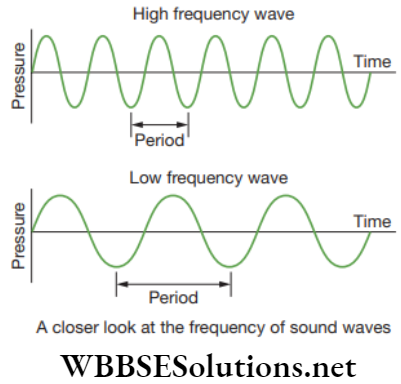
Sound Needs Medium to Travel
Amedium is necessary forthe propagation of sound from one place to another. The matter or substance through which sound is transmitted is called a medium. The medium can be solid, liquid, or gas. Sound cannot travel in vaccum. A true vaccum refers to the complete absence of matter.
Sound waves can travel only through matter. So, sound needs a physical medium in order to travel anywhere. A vibrating object travels from one place to another through the mechanical vibrations of medium particles in the form of waves.
Activity to Show that Sound Needs a Material Medium for its Propagation
Take an electric bell and suspend it inside an air tight glass bell jar. Connect the bell jar to a vacuum pump. When the key is pressed, the circuit of electric belt is complete. The hammer of the electric bell begins to strike the gong repeatedly due to which sound is heard. Now keeping the key pressed, air is gradually with drawn from the jar by starting the vacuum pump.
It is noticed that the loudness of sound goes on decreasing as the air is removed from the bell jar and finally no sound is heard when all the air from the jar has been drawn out. The hammer of the electric bell is still seen striking the gong repeatedly which means that sound is still produced, but it is not heard.
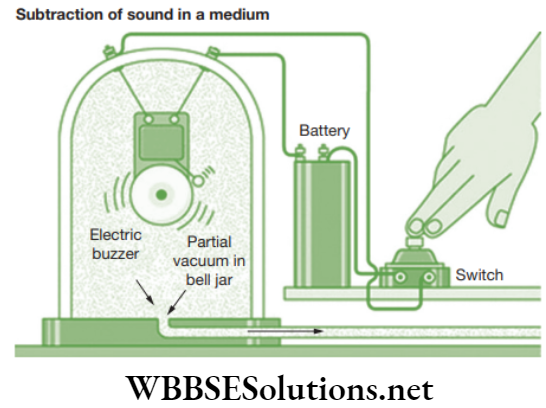
Illustration
When hammer of the bell hits the gong, sound is produced due to vibrations of gong which travels through air to the wall of jar. This causes the wall of jar to vibrate and the air outside the jar is also set in vibration. Therefore, we can hear the sound.
But when hair has been removed from the jar, sound produced due to vibration of gong could not travel to the wall of jar, so wall could not vibrate, hence no sound is heard. This clearly demonstrates that sound requires a material medium for transmission and it cannot travel through vacuum.
Requisites of the Medium
The medium required for propagation of sound must have the following properties:
- The medium must be elastic so that its particles may come back to their initial positions after displacement on either side.
- The medium must have inertia so that its particles may store mechanical energy.
- The medium should be frictionless so that there is no loss of energy in propagation of sound through it.
We know sound can propagate in all states, i.e., solid, liquid and gas. Some materials like water, air, etc., can easily transmit sound from one place to another while on the other hand materials like blanket, thick curtains, etc., transmit only a small fraction of it because it absorbs most of the sound incident on them.
Sound Propagates as Waves
Sound propagates from one place to another in the form of waves, i.e. because of the disturbances of particle of the medium. Wave is a phenomenon or disturbance in which energy is transferred from one point to another without any direct contact between the points. So, sound is considered as a wave. Particle of medium only vibrate. They do not move from one point to another.
On the basis of direction of propagation, waves can be divided into two types – (a) longitudinal waves and (b) transverse waves
Longitudinal Waves
A wave in which particles of the medium vibrate about their mean positions, in the direction of propagation of the wave is called longitudinal wave (Fig. 5.5). Sound travels in air in the form of longitudinal waves. Longitudinal waves can be produced in all forms, i.e., solid, liquid and gas. At compressions, the density and pressure of the medium are maximum, while at rarefaction the density and pressure of the medium are minimum.
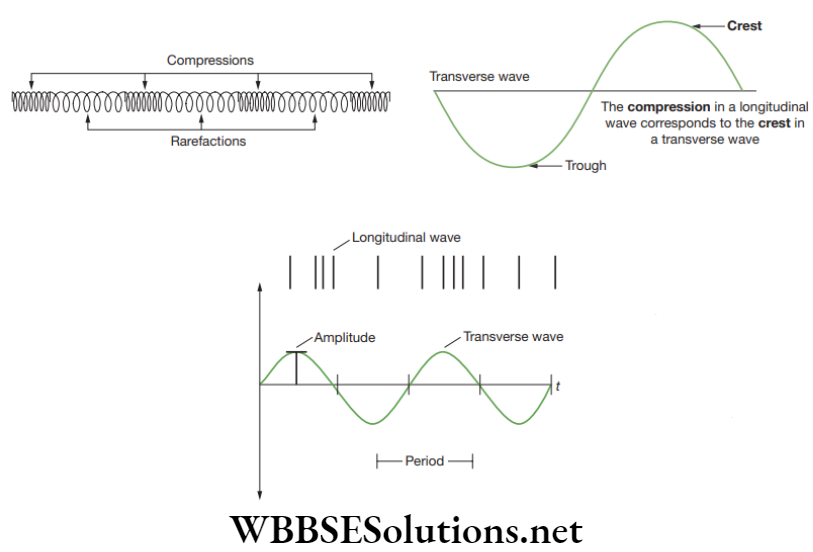
Compression and Rarefaction
Air is the most common medium through which sound travels. When a vibrating object moves forward, it pushes and compresses the air in front of it creating a region of high pressure. This region is called compression. It is represented by the symbol C.
When the vibrating object moves backwards, it creates a region of low pressure called rarefaction. It is represented by the symbol R.
In the we see that waves are formed when a stone is dropped on the still water surface. Along with waves we also hear sound of stone as the stone strikes the water surface. This is due to the disturbance produced in water. The disturbance spreads in all directions rapidly outwards in the form of circular waves on the surface of water.

Now keep a small paper boat on the water surface at some distance away from the point where the stone strikes, we notice that the ball doesn’t move ahead, instead it will vibrate in the up and down direction as the wave moves ahead. The reason behind this is that the particles of water start vibrating up and down at the point where the stone strikes.
These particles then transfer their energy to other neighbouring particles and they themselves come back to their mean positions. This process continues and thus the disturbance moves ahead on the water surface in the form of waves. The waves die out as soon as the energy imparted by the stone gets dissipated.
Transverse Wave
A wave in which the particles of the medium vibrate about their mean positions, in a direction perpendicular to the direction of propagation of the wave is called a transverse wave.
Transverse wave is composed of:
- Crest: The position of maximum upward displacement is called crest.
- Trough: The position of maximum downward displacement is called trough.
Comparison between transverse and longitudinal waves
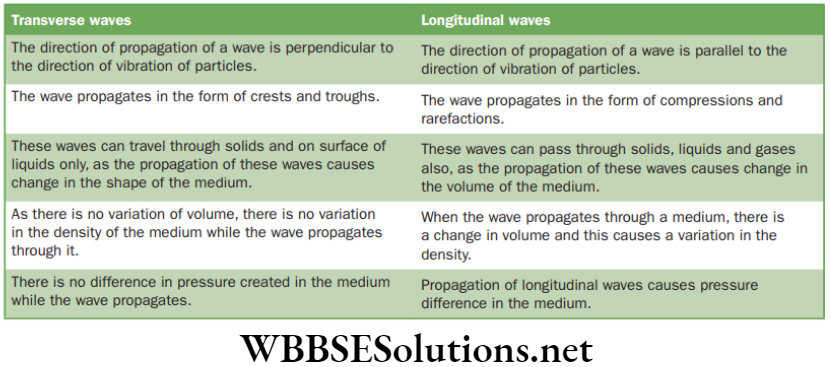
Progressive and Stationary Waves
There are some waves that start at the point of origin of the waves and progress endlessly into other parts of the medium. Such waves are known as progressive waves.
Consider a progressive transverse water wave moving from left (point P) to right and striking a hard surface at ‘Q’and is called an ‘incident wave’. It then gets reflected at ‘Q’, and travels towards ‘P’. Thus the two waves, one going from ‘P’ to ‘Q’ and the other going from ‘Q’ to ‘P’ called the ‘reflected wave’ overlap resulting in the formation of ‘nodes’ and ‘antinodes’.
Points, where the displacement of a vibrating particle of the medium is zero or minimum are called ‘nodes’ and points, where the displacement of the vibrating particles is maximum are called ‘antinodes’. The closed figures so formed are called ‘Loops’.
These loops are On the whole, the wave appears to be stationary or standing, contained between two positions ‘P’ and ‘Q’ and so called as ‘stationary waves’ or ‘standing’. Thus a ‘progressive wave is a wave which is generated at a point in a medium and travels to all parts of the medium infinitely carrying the energy’ and a ‘stationary wave is a wave which is formed by a superposition of two identical progressive waves traveling in opposite directions’.
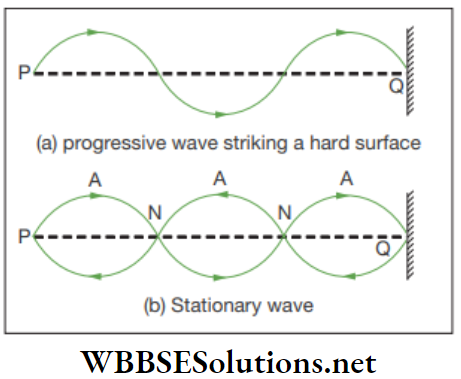
Comparative study of progressive and stationary waves
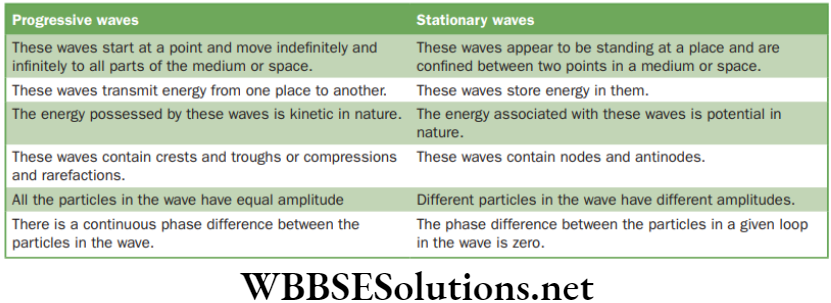
Characteristics of Wave Motion
- A wave is produced by the periodic disturbance at a point in the medium.
- Due to propagation of a wave in a medium, the particles of the medium vibrate about their mean positions and energy is transferred with a constant speed from one place of medium to the other.
Characteristics of Sound Wave
Sound can be described in terms of the following physical quantities:
1. Amplitude: The maximum displacement of the particle of a medium on either side of its mean position is called amplitude of the wave. It is denoted by the symbol ‘A’. S.I. Its unit is metre (m).
2. Time period: The time taken by a particle of the medium to complete its one vibration is called time period of the wave. It is denoted by the letter T. Its S.I. unit is second (s).
3. Frequency: The number of vibrations made by a particle of the medium in one second is called frequency of wave.
Another definition is number of waves passing through a point in one second.
It is denoted by the symbol n, f, neu (υ)
Its S.I. unit is hertz (Hz) or s-1.
Relation:
υ = 1/T
where υ = frequency, T = time period.
The frequency of a wave is equal to the frequency of vibrations of its source. It is the characteristic of its source which produces the disturbance. It does not depend on the amplitude of vibration or on the nature of medium in which the wave propagates.
4. Wavelength: The distance travelled by the wave in the time period of vibration of particles in the medium is called its wavelength. It is denoted by the letter λ (lambda). Its S.I. unit is metre (m). It depends on the medium in which the wave travels.
In a longitudinal wave, the distance between two consecutive compressions or two consecutive rarefactions is equal to one wavelength.
In a transverse wave, the distance between two consecutive crests or between two consecutive troughs is equal to one wavelength.
5. Wave velocity: The distance travelled by a wave in one second is called its wave velocity. It is the velocity with which energy is transferred from one place to another by wave motion. It is not the velocity of an individual particle vibrating about its mean position.
Wave velocity is constant for a given medium. It depends on the elasticity and the density of the medium. It changes when same wave passes from one medium to the other medium. It is denoted by the letter v. Its S.I. unit is m/s.
Displacement–Time Graph
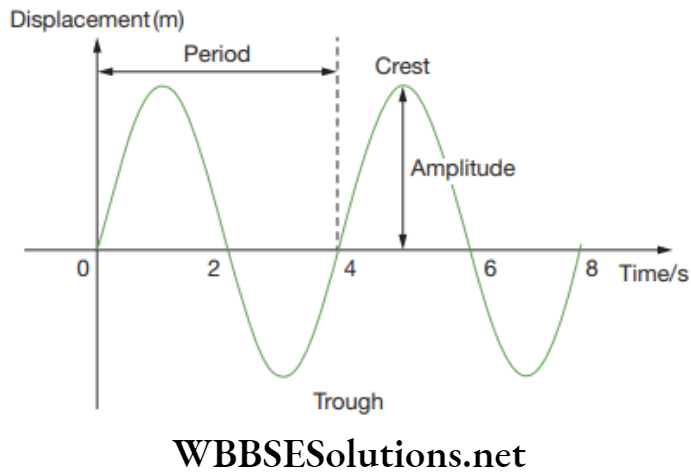
The above graph shows the variation of displacement of a certain particle of the medium with time, when a wave propagates through it. It is called displacement–time graph.
Displacement–Distance Graph
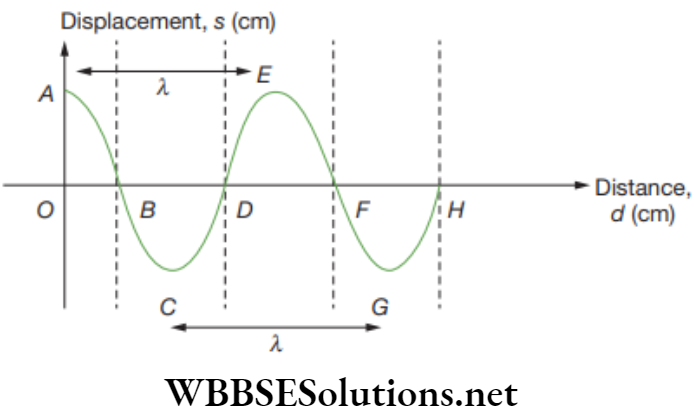
The above figure shows the displacement–distance graph of a transverse wave at an instant. It is a snapshot of a wave. Distance AE or CG gives us the wavelength (λ) of the wave.
Relationship between Wavelength, Wave Velocity and Frequency
Let velocity of wave = v
Time period = T
Frequency = υ
Wavelength = λ
As per the definition of wavelength,
λ = Distance travelled by wave in one time period
= Wave velocity × Time period
= v × T
vT = λ
T = 1/υ
v × (1/υ) = λ
Therefore,
v = λυ
Hence,
Wave Velocity = Frequency × Wavelength.
Speed of Sound in Different Media
Sound travels in a medium with a finite speed and it takes some time to reach a destination from the source.
The speed of sound in a medium depends on the following factors:
- Elasticity of (E) of the medium
- Density (r) of the medium
The speed of sound in a medium is given by the formula
v = \(\sqrt{\frac{E}{\rho}}\)
where E is the modules of elasticity and ρ is the density of medium.
Sir Isaac Newton assumed, when sound travels in a gas, temperature of the gas does not change. In other words, the propagation of sound is an isothermal change. For isothermal change, modulus of elasticity is equal to the pressure of the gas, i.e. E = P.
Therefore, velocity of sound in gas was given by
v = \(\sqrt{\frac{P}{\rho}}\)
The expression given by Newton for the velocity of sound in a gas medium, later was modified by Laplace, where he introduced ‘γ ’, as a constant for a given gas. It is defined as the ratio of the specific heat capacity of the gas at constant pressure to its specific heat capacity at constant volume.
Therefore, v = \(\sqrt{\left(\frac{\gamma P}{d}\right)}\), where, ‘γ ’(gamma) is a constant.
The speed of sound is different in different media. It is more in solids, less in liquid and least in gas. This is because solids are much more elastic than the liquids and gases. The speed of sound is nearly 5100 m/s in steel, 1450 m/s in water and 330 m/s in air at 0 °C. Table 5.3 below gives the speed of sound in different media at 0 °C.
Speed of sound in different media
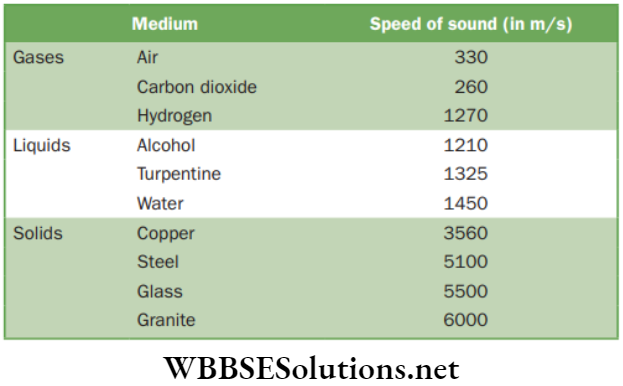
Example: If sound is produced at one end of a very long steel bar, two sounds are heard at the other end. One which reaches first is propagated through steel and the other which is heard later is through air.
Factors Affecting the Velocity of Sound in a Air
The speed of sound in a gas is affected by
1. Effect of density: As we know v = \(\sqrt{\frac{\gamma P}{\rho}}\), it shows that \(v \propto \frac{1}{\sqrt{\rho}}\)
The speed of sound is inversely proportional to the square root of density of the gas.
The density of oxygen is 16 times the density of hydrogen; therefore the speed of sound in hydrogen is four times the speed of sound in oxygen other factor being same.
2. Effect of temperature: The speed of sound in a gas increases with the increase in the temperature of the gas. This is because with the increase of temperature, density of gas decreases and consequently the speed of sound increases.
Speed of sound is directly proportional to the square root of temperature of medium.
\(V \propto \sqrt{T}\) , where T is the temperature of the gas on the Kelvin scale.
The speed of sound in air increases by about 0.61 m/s for each degree celsius rise in its temperature.
Vt = V0 + 0.61 t
where ‘t’ is temperature of air in °C.
3. Effect of humidity: The speed of sound in air increases with the increase in humidity in air.
The density of water vapour is about 5/8th times the density of dry air at ordinary temperatures, therefore the increase of moisture in air tends to decrease the density of air. This is the reason why the speed of sound in the humid air is greater than the speed of sound in the dry air.
4. Effect of direction of wind: The speed of sound increases or decreases according to the direction of wind. If wind is blowing in the direction of propagation of sound, the speed of sound increases but if it is flowing in the direction opposite to that of sound, then speed of sound will decrease.
If v is the speed of sound in still air and W is the speed of wind, the speed of sound becomes v + W when wind blows in the direction in which sound travels and the speed of sound becomes v – W when wind blows in direction opposite to the direction in which sound travels.
Factors not Affecting the Velocity of Sound in a Air
The velocity of sound in air is not affected by the change in
- Wavelength (λ): The velocity of sound in air or any other medium does not depend on its wavelength (λ).
- Frequency (n): The velocity of sound in air or any other medium does not depend on its frequency.
We know that v = nλ. As the frequency (n) increases, its wavelength (λ) decreases but does not affect the velocity of the wave. - Amplitude: Velocity of sound does not depend on the amplitude of the vibrations.
- Pressure: The velocity of sound in air or any gas in given by v = \(\sqrt{\frac{\gamma P}{d}}\); where ‘γ ’ is a constant, ‘P’ is the pressure and ‘d’ is the density.
When the pressure of a gas is changed, its density also changes such that the ratio ‘P’/d is always a constant. Therefore, the variation of pressure of a gas does not affect the velocity of sound in it.
Comparison of Speed of Sound with Speed of Light
- The light can travel in vacuum but sound cannot.
- The speed of light in air is 3 × 108 m/s which is about a million times greater than the speed of sound in air. (i.e. 330 m/s at 0 °C).
- The speed of light decreases in an optically denser medium while the speed of sound is more in solids, less in liquids and least in gases.
- In thunder, light is seen much earlier than sound of thunder is heard, even though they are produced simultaneously.
- In an athletic event, when the starter fires a gun, the sound of fire is heard a little later while the smoke is instantaneously seen. The reason is that vlight > Vsound .
Characteristics of Sound as we Hear It
1. Loudness: Loudness of sound is the measure of sound energy reaching the ear per second. Loudness or softness of a sound wave is the sensation that depends upon its amplitude.
E.g. When we strike the top of a table with more force, it vibrates and produces a loud sound. But, when we strike the top of table with lesser force, the vibrating table top produces soft sound waves. Louder sound has more amplitude.
2. Pitch: When a guitar n flute are played together then the sound emitted by the two musical instruments are different. The difference is due to one more characteristic of sound namely pitch.
Pitch is the sensation (brain’s interpretation) of the frequency of an emitter sound. The pitch of sound (Shrillness or flatness) depends on the frequency of vibration.
Faster the vibration of the source, higher is the frequency and higher the pitch and vice versa, Similarly, low pitch sound corresponds to low pitch.
3. Quality or Timbre: Quality or timbre of sound wave is that characteristic which helps us in distinguishing between two sounds of same loudness and same pitch.
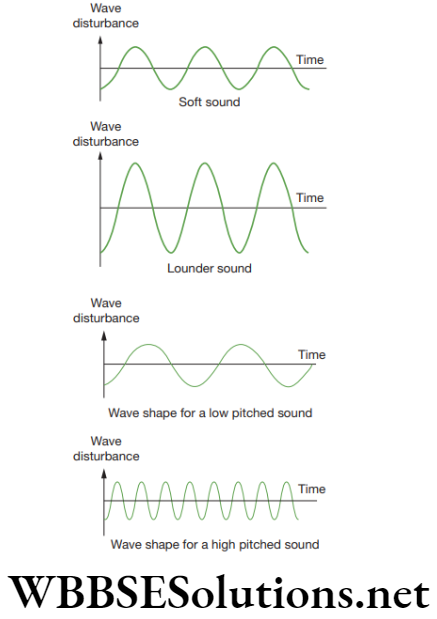
Music and Noise
- Music is the sound that is pleasant to hear/to the ears (e.g, sound coming out of musical instruments)
- Noise is the sound that is unpleasant to hear/the ears (E.g., Sound produces by vehicles)
Tone and Note
- A pure sound of single frequency is called tone.
- An impure sound produced by mixture of many frequencies is called a note. It is pleasant to hear.
Sonic Boom: Speed of sound in air is 333 m/s, speed of faster runner = 12.5 m/s. Many objects such as aircrafts, bullets, and rocket planes travel at speed greater than the speed of sound in air. Such objects are said to be travelling with supersonic speed.
- Objects moving with speed greater than speed of sound is said to have supersonic speed.
- Supersonic aircraft produces shock waves in air due to its very high speed. The air pressure variation associated with shock waves produces a very sharp and loud sound called “Sonic boom”.
Chapter 5 Sound Reflection of Sound
Sound gets reflected at the surface of solid and liquid in the same way as light does. It follows the law of reflection. Bouncing back of sound wave from the surface of a solid or a liquid is called reflection of sound.
- The laws of reflection are as follows:
- The angle of incidence is equal to the angle of reflection.
The incident ray, reflected ray and normal at the point of incidence, they all lie in the same plane.
we have taken two identical cardboard tubes and arrange them as shown in the figure near the hard plywood. At one end of the cardboard, put in an alarm clock. Now try to listen to the clock tick-tock from the other by adjusting the position of the cardboard. Now measure the angles of incidence and reflection. Now lift the second pipe and try to hear the sound.
In this experiment you will notice that the angle of incidence is equal to the angle of reflection. Incident ray, reflected ray and normal all lie in the same plane.
Instead of hard plywood we can use any obstacle of big size which is either polished or rough. This is used for the reflection of sound waves.
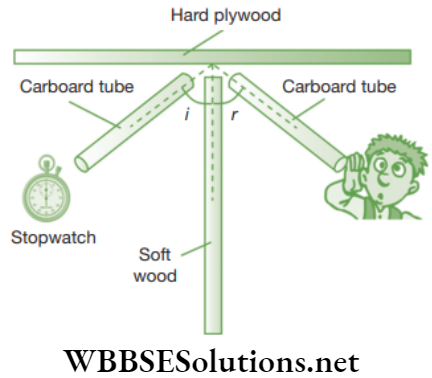
Echo
The sound that comes to our ear after reflection is called echo or echo of sound.
Examples
- Sound we hear after clap is an echo.
- Sound heard after shouting in a big empty hall is also an echo.
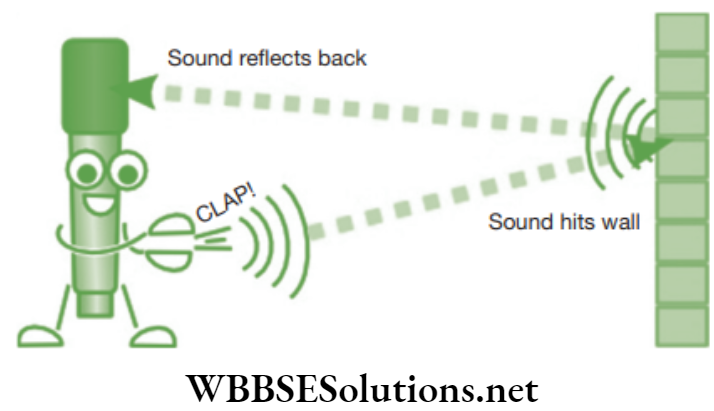
The sensation of sound remains in human brain for about 0.1 s. It means the time interval between the original sound and echo must be at least 0.1 s. At times echo is heard multiple times. This happens when there is successive or multiple reflections. For example, thunderstorm.
As we know the speed of sound in air is 344 m/s. The distance travelled by sound in 0.1 s will be
D = v × T
= 344 × 0.1
= 34.4 m
It means to hear the echo properly, the minimum distance of the reflecting surface should be half of this distance, i.e. 34.4/2 = 17.2 m.
Temperature has impact on echo. So when temperature changes, distance will also change.
Reverberation
When echo is heard multiple times due to repeated and multiple reflections of sound from different reflecting surfaces, it causes persistence of sound. This is called reverberation.
Example: Sound echoes multiple times, when a man shouts at a top of the mountain cliff.
At places like auditorium, big halls sound echoes multiple times. To reduce reverberation, roofs and walls are covered by sound absorbing materials. These can be rough plaster, draperies or compressed fibre board. Reverberation can be prevented by stopping the reflection of sound. This could be done by:
- Using soft sound absorbent material, such as curtains, plant fibres, compressed fireboard, carpets are used in big halls.
- These materials absorb undesired reflected sound and reduce reverberation.
Uses of Multiple Reflection of Sound
On one hand reflection of sound can be irritating but on the other side it proves to be helpful. Let us see some examples where reflection of sound is useful.
1. Loudspeaker, Megaphone, Bulb horn: Devices like loudspeaker, megaphones are designed in such a way that they send the sound in a particular direction by multiple reflections without deviating it into various directions.
2. Soundboard: Soundboard is used in big halls or auditoriums where sound is sent towards auditorium. It works on the basis of law of reflection of sound waves.


Soundboard is a big concave board and it is placed behind the stage in such a manner that it focuses the speaker. Sound that is coming from the speaker falls on the soundboard which in turn gets reflected towards the audience. The result of this is that the audience who are sitting far from the speaker can easily hear the sound that is coming out from the speaker.
The walls of auditorium are also constructed in the form of curve. Hence, ceiling acts like a soundboard.
3. Stethoscope: Stethoscope is an instrument used by doctors for listening human breath. In stethoscope, human body’s sound is received by chest piece which is sent to ear by multiple reflections done inside the long tube.
Use of Multiple Reflection of Sound
- Measuring the depth of sea or ocean.
- Used for the detection of the position of objects. For example, sea rocks, hidden ice-berg in the sea and ocean shipwrecks.
- Investigating problem inside the human body.

Chapter 5 Sound Range of Hearing
The human ear is able to hear sound in a frequency range of about 20 Hz to 20,000 Hz. In other words the audible range of frequency is 20 Hz to 20 kHz. Any sound out of this range is called not audible.
The audible range of frequency varies from person to person and it also varies with age of the person. As the person grows older, his hearing power decreases.
Children can hear higher frequencies of up to 30 kHz while an old person can hear up to 12 kHz. Therefore, on an average the audible range is from 20 Hz to 20 kHz.
The human ear is most sensitive in the range 2 kHz to 3 kHz, where it can hear even a very feeble sound. Unlike human, animals can hear sounds of frequency below 20 Hz and above 20 kHz. Different animals have different range of frequency. Frequency ranges for hearing and speaking by humans and animals.
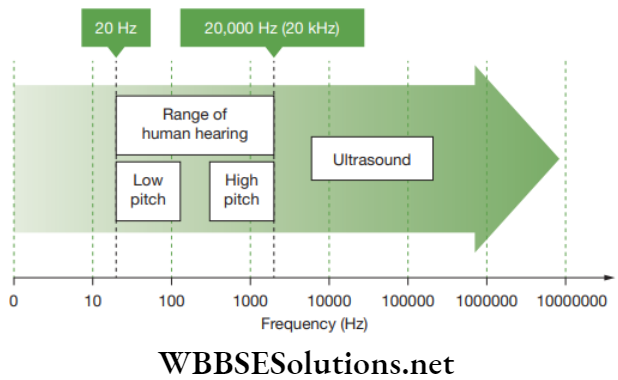

Let us see the frequency ranges for hearing and speaking of various animals and human.
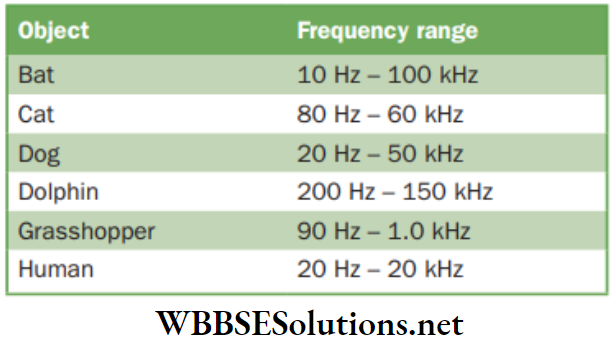
Chapter 5 Sound Ultrasound and Its Applications
As studied in the last topic, the frequency of sound above 20 kHz is called ultrasound. Ultrasound can travel freely in solids and liquids. In case of gases, its intensity falls. In the medium, the speed of ultrasound is same as that of audible sound. In air, the speed of ultrasound is 330 m/s.
Properties of Ultrasound
Ultrasound has all the properties that an ordinary sound has. But because of its high frequency it has two additional properties.
- The energy carried by ultrasound is very high.
- The ultrasound can travel along a well-defined straight path. It does not bend appreciably at the edges of an obstacle because of its small wavelength.
The above properties of ultrasound make it very useful for different purposes. It is extensively used in industries and for medical purposes.
Applications of Ultrasound
Some applications of ultrasound are given below:
- Bats avoid obstacles in their path by producing and hearing the ultrasound. They emit ultrasound which returns after striking an obstacle in their way. By hearing the reflected sound and from the time interval, they can judge the direction and the distance of the obstacle in their way.
- Ultrasound is used for drilling holes or making cuts of desired shape in materials like glass.
- It is used for cleaning very small objects like cleaning parts of watches or other electronic items. The objects are placed in the cleaning solution and ultrasonic waves are passed in the solution. This causes high frequency vibrations in the solution and makes the cleaning easier.
- Ultrasound is used for detection of defects in metals. Ultrasound will pass through the object if there is no defect but if there is some defect, ultrasound will get reflected back.
- Ultrasound is widely used for imaging the human organs. Ultrasonography is used to obtain the images of patient’s organs such as liver, gall bladder, uterus, etc. It helps to detect stone, tumour, etc. Echo cardiology is used to obtain the image of the heart.
- Ultrasound is used in surgery to remove cataract and in kidneys to break the stone in fine grains.
- In SONAR (abbreviated form of sound navigation and ranging) to detect and find the distance of objects under water, ultrasound is used.
Infrasonics or Infrasound
Infrasonic waves are the waves which has frequency less than 20 Hz. These waves are produced by large vibrating bodies. For example they are produced by the vibration of the earth’s surface during the earthquake.
These waves are also produced by some animals like elephants, rhinoceroses, whales, etc. These waves are not audible to human ears.
It has been observed that the animal’s behaviour becomes unusual just before tremor is felt. This is because the animals have the ability to detect infrasonic waves produced at the time of tremor.
Sound Navigation and Ranging (SONAR)
SONAR is a device which is used in the ships to locate rocks, icebergs, and submarines, old sank in seas etc.
Ultrasonic waves of high frequency are sent from a ship on the surface. The waves travel in straight line till they hit somebody like shipwreck or submarine. On hitting the body these waves are reflected back as shown in figure.
The transmitter sending the wave notes the time t between sending the signal and receiving it back. Let if d is the distance of the submarine from the ship, than the total distance travelled by the wave in time interval t is 2d.
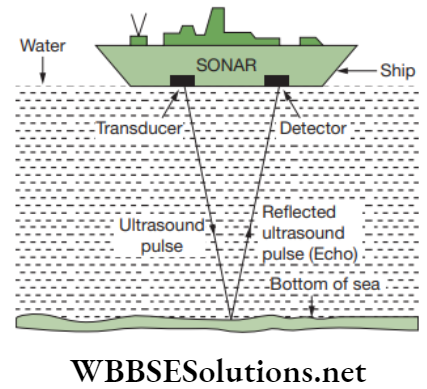
v = \(\frac{2 d}{t}\)
Therefore d = \(\frac{1}{2}(v \times t)\)
The velocity v of the ultrasonic wave in water is same as that of audible range of water.
Chapter 5 Sound Master Your Test Question And Answers
Question 1. Describe various uses of multiple reflections of sound.
Answer:
Various uses of multiple reflections of sound:
Multiple reflection of sound is used to measure the depth of sea or ocean. It is also used to detect the position of objects for example sea rocks, hidden iceberg in the sea and ocean shipwrecks. It is also used to investigate problems inside the human body.
Question 2. What is the range of hearing of human being?
Answer:
Range of hearing of human being:
The range of hearing of human being is the sound of frequency between 20 Hz to 20000 Hz.
Question 3. Define infrasonic and ultrasonic sounds.
Answer:
Infrasonic and ultrasonic sounds:
The sound of frequency less than 20 Hz is called infrasonic sound while the sound of frequency greater than 20 kHz is called ultrasonic sound.
Question 4. What are the additional properties of ultrasound?
Answer:
The additional properties carried by ultrasound are:
- The energy carried is very high.
- It can travel along a well-defined straight path. It does not bend appreciably at the edges of the obstacle because of its small wavelength.
Question 5. What are the various applications of ultrasound?
Answer:
The various applications of ultrasound are:
- Bats avoid obstacles in their path by producing and hearing the ultrasound.
- It is used in drilling holes and making cuts of desired shape in the glass.
- It is used in cleaning very small objects like parts of watches or other electronic items.
- It is used for detection of defects in the metals.
- It is widely used for imaging of human organs.
- It is used in human surgery to remove cataract and in kidneys to break the stone in fine grains.
- It is used in SONAR (Sound navigation and ranging)
Chapter 5 Sound Structure of Human Ear
Ear acts as a receiver or detector of sound. The sound that is received in the form of pressure variations in air are converted into electrical signals within the ear. This sound on reaching our brain produces a sense of hearing. The human ear consists of three parts:
1. Outer ear: The outer ear looks complicated but it is functionally the simplest part of the ear. It consists of the ‘pinna’ or auricle (the visible projecting portion of the ear), the external acoustic meatus (the outside opening to the ear canal), and the external ear canal that leads to the ear drum. In sum, there is the pinna, the meatus and the canal. That’s all. The outer ear concentrates air vibrations on the ear drum and makes the drum vibrate. The outer ear is also called external ear.
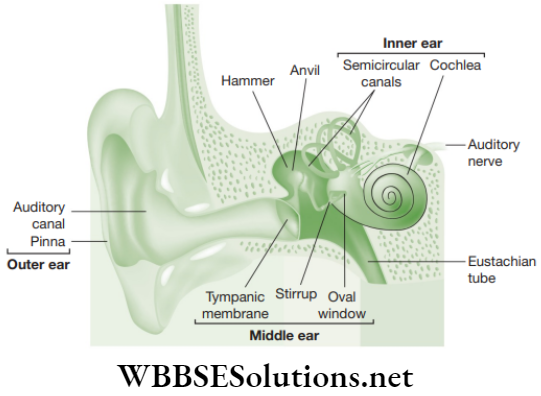
2. Middle ear: The middle ear consists of an eardrum or tympanic membrane connected at the end of the auditory canal. The eardrum is a thin, tightly stretched membrane, also known as sheet (‘kaan ka parda’ in Hindi). The eardrum vibrates when compressions and rarefactions of sound wave hit it. A compression exerts an inward pressure on the outer surface of the eardrum. This forces the eardrum to move inward. However, a rarefaction does the opposite and moves the eardrum outwards.
Hence, the eardrum is made to vibrate by the successive compressions and rarefactions. The vibration of eardrum produces pressure variations within the middle ear. The three bones (hammer, anvil and stirrup) present in the middle ear amplify these pressure variations several times. The middle ear then transmits the sound wave’s amplified pressure variations to the inner ear.
3. Inner ear: The inner ear has a job to convert the sound wave’s amplified pressure variations into electrical signals. This work is done in the inner ear by cochlea, a snail-shaped organ. The cochlea is filled with water like fluid and its inner surface has large number of hair-like nerve cells.
The amplified pressure variations produce vibrations in the nerve cells and they in turn release electrical impulses. The electrical impulses are transmitted to the brain along the auditory nerve. The brain interprets the electrical impulses through a complex process, as sounds.
Chapter 5 Sound
Question 1. ______ acts as a receiver or detector of sound.
Answer. Ear
Question 2. The simplest part of ear is
- Inner ear
- Middle ear
- Outer ear
- Cerebellum
Answer. 3. Outer ear
Question 3. The ______ vibrates when compressions and rarefactions of sound wave hit it.
Answer. Ear drum
Question 4. The ______ has a job to convert the sound wave’s amplified pressure variations into electrical signals.
Answer. inner ear
Chapter 5 Sound Practice Exercises
Question 1. Note is a sound
- of mixture of several frequencies
- of mixture of two frequencies only
- of a single frequency
- always unpleasant to listen
Answer. 3. of a single frequency
Question 2. A key of a mechanical piano struck gently and then struck again but much harder this time. In the second case
- sound will be louder but pitch will not be different
- sound will be louder and pitch will also be higher
- sound will be louder but pitch will be lower
- both loudness and pitch will remain unaffected
Answer. 1. sound will be louder but pitch will not be different
Question 3. In SONAR, we use
- ultrasonic waves
- infrasonic waves
- radio waves
- audible sound waves
Answer. 1. ultrasonic waves
Question 4. Sound travels in air if
- particles of medium travel from one place to another
- there is no moisture in the atmosphere
- disturbance moves
- both particles as well as disturbance travel from one place to another.
Answer. 3. disturbance moves
Question 5. When we change feeble sound to loud sound we increase its
- frequency
- amplitude
- velocity
- wavelength
Answer. 2. amplitude
Question 6. In the curve half the wavelength is
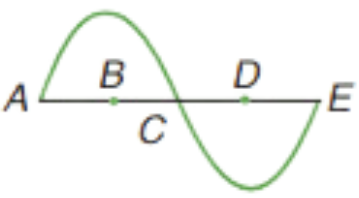
- A B
- B D
- D E
- A E
Answer. 2. B D
Question 7. Earthquake produces which kind of sound before the main shock wave begins
- ultrasound
- infrasound
- audible sound
- none of the above
Answer. 2. infrasound
Question 8. Infrasound can be heard by
- dog
- bat
- rhinoceros
- human beings
Answer. 3. rhinoceros
Question 9. Before playing the orchestra in a musical concert, a sitarist tries to adjust the tension and pluck the string suitably. By doing so, he is adjusting
- intensity of sound only
- amplitude of sound only
- frequency of the sitar string with the frequency of other musical instruments
- loudness of sound
Answer. 3. frequency of the sitar string with the frequency of other musical instruments
Chapter 5 Sound Fill in the Blanks
Question 1. Sound shows______variation with temperature.
Answer. Speed
Question 2. Infrasonic sound has less ______.
Answer. Frequency
Question 3. 1 kHz = ______Hz
Answer. 1000
Question 4. The maximum displacement of a wave from its mean position is known as ______.
Answer. Amplitude
Question 5. Wavelength is denoted by the symbol ______.
Answer. λ
Question 6. _____ is the unit of loudness of sound.
Answer. Decibel
Question 7. Echo is observed usually in ______ rooms.
Answer. Large
Question 8. In SONAR, ‘S’ stands for ______.
Answer. Sound
Question 9. In order to distinguish between two different sounds, they must be heard after an interval of ______.
Answer. 0.1 s
Question 10. If the time period is 0.05 second, then the frequency is ______ Hz.
Answer. 20
Chapter 5 Sound Match the Columns
Question 1. Choose the correct speed (m/s) of substance at temperature 25 °C.
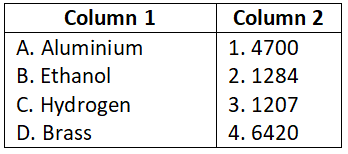
Select the correct option:
- A-1, B-2, C-3, D-4
- A-4, B-3, C-2, D-1
- A-2, B-1, C-3, D-4
- A-1, B-2, C-4, D-3
Answer. 2. A-4, B-3, C-2, D-1
Question 2. Choose the correct S.I. unit.
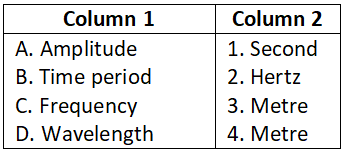
Select the correct option:
- A-1, B-2, C-3, D-4
- A-4, B-3, C-2, D-1
- A-2, B-1, C-3, D-4
- A-4, B-1, C-2, D-3
Answer. 4. A-4, B-1, C-2, D-3
Question 3. Choose the correct symbol.
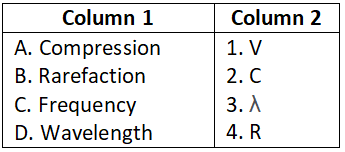
Select the correct option:
- A-1, B-2, C-3, D-4
- A-2, B-4, C-1, D-3
- A-2, B-1, C-3, D-4
- A-4, B-1, C-2, D-3
Answer. 2. A-2, B-4, C-1, D-3
Question 4. Choose the correct code.
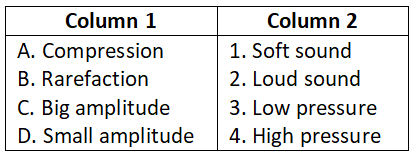
Select the correct option:
- A-1, B-2, C-3, D-4
- A-2, B-4, C-1, D-3
- A-2, B-1, C-3, D-4
- A-4, B-1, C-2, D-3
Answer. 2. A-2, B-4, C-1, D-3
Chapter 5 Sound Assertion Reasoning
Direction: For the following questions the options will remain the following:
- Both A and R are correct and R is correct explanation of A.
- Both A and R are correct but R is not a logical explanation of A.
- A is correct but R is incorrect.
- R is correct but A is incorrect.
Question 1. Assertion: A boy shouts near mountain, he hears his sound again.
Reason: This is because of the reflection of sound.
Answer. 1. 1. Both A and R are correct and R is correct explanation of A.
Question 2. Assertion: Ultrasonic sound is used to clean electronic components.
Reason: Due to low frequency, dirt particles get detached from the components.
Answer. 2. Both A and R are correct but R is not a logical explanation of A.
Question 3.Assertion: The ceilings of concert halls and conference halls are made curved.
Reason: This way sound wave reaches all thepart after reflection from the curved surface.
Answer. 1. Both A and R are correct and R is correct explanation of A.
Chapter 5 Sound Comprehension Passage
Heinrich Rudolf Hertz was born on 22 February, 1857 in Germany. He was a German physicist. He was the first person who proved the existence of electromagnetic waves by his experiments. He laid the foundation for future development of radio, telephone, telegraph and television.
He also discovered the photoelectric effect when he noticed that the charged object loses its charge quickly when illuminated by ultraviolet radiation. It was later explained by Albert Einstein.
He also started experimenting on cathode rays. He discovered that cathode rays can penetrate in thin\ metal foil. He developed a version of cathode tube and worked on X-rays of different materials. But he never practically worked on actual 0020X rays.
The S.I. unit of frequency was named as Hertz in his honour.
Question 1. What is the S.I. unit of frequency?
- Hertz
- Metre
- Second
- m/s
Answer. 1. Hertz
Question 2. When was Hertz born?
- 15 March, 1857
- 22 February, 1857
- 22 February, 1859
- 19 November, 1882
Answer. 2. 22 February, 1857
Question 3. Which city was Hertz born?
- London
- Germany
- Indonesia
- America
Answer. 2. Germany
Question 4. Hertz was the first person to introduce ______.
- Electromagnetic waves
- Magnetic waves
- Electricity
- Gas
Answer. 1. Electromagnetic waves
Question 5. What was the full name of Hertz?
- Henry Hertz
- Rudolf Hertz
- Heinrich Hertz
- Heinrich Rudolf Hertz
Answer. 4. Heinrich Rudolf Hertz
Chapter 5 Sound Integer Type Question And Answers
Question 1. A sound source sends waves of 400 Hz. It produces waves of wavelength 2.5 m. What is the velocity of sound waves?
Answer. 1000 m/s
Question 2. The time period of a vibrating body is 0.05 s. What is the frequency of waves that it emits?
Answer. 20 Hz
Question 3. A bat can hear sound of frequencies up to 120 kHz. Determine the minimum wavelength of sound which it can hear. Speed of sound in air to be 344 m/s.
Answer. 2.867 x 10-3 m
Question 4. A wave pulse of frequency 200 Hz, on a string moves a distance 8 m in 0.05 s. Calculate the wavelength of wave on string.
Answer. 0.8 m
Question 5. If velocity of sound in air is 340 m/s and frequency is 256 Hz. What will be the wavelength?
Answer. 1.25 m

